Abstract
Diarrhoea, which is present in roughly one third of cases of medullary carcinoma of the thyroid, was investigated in five cases.
Excessive loss of water and electrolytes in the stools was the major factor. Steatorrhoea was mild or absent, and intestinal absorption of glucose and vitamin B12 was normal; the histological appearance of the small intestinal mucosa was normal or subnormal. Water and sodium diarrhoea seems to be linked to a sometimes considerable increase in the rate of transit through the small intestine and colon, and may be relieved by codeine or codethyline. The frequent increase in the maximum blood sugar level during an oral tolerance test should not be interpreted as evidence of a paradiabetic condition. In fact, the intravenous glucose tolerance test is usually normal and the excessive rise in blood sugar after oral administration seems to be the consequence of the increased rate of transit through the small intestine.
The link between the tumour and the disordered motility seems definite in view of certain cases in which removal of the tumour caused the diarrhoea to disappear immediately. Production by the tumour of serotonin or other derivatives of tryptophan or of kallikrein, which activates bradykinin, is rare. With regard to prostaglandins, high concentrations have been observed in the tumours and in the venous blood draining the tumours, but their presence in systemic blood is inconstant. The only hormonal substance, concentration of which seems to be definitely increased in the systemic blood of patients with a medullary carcinoma of the thyroid, is thyrocalcitonin but this hormone does not seem to have any effect on the motor activity of the digestive tract.
Full text
PDF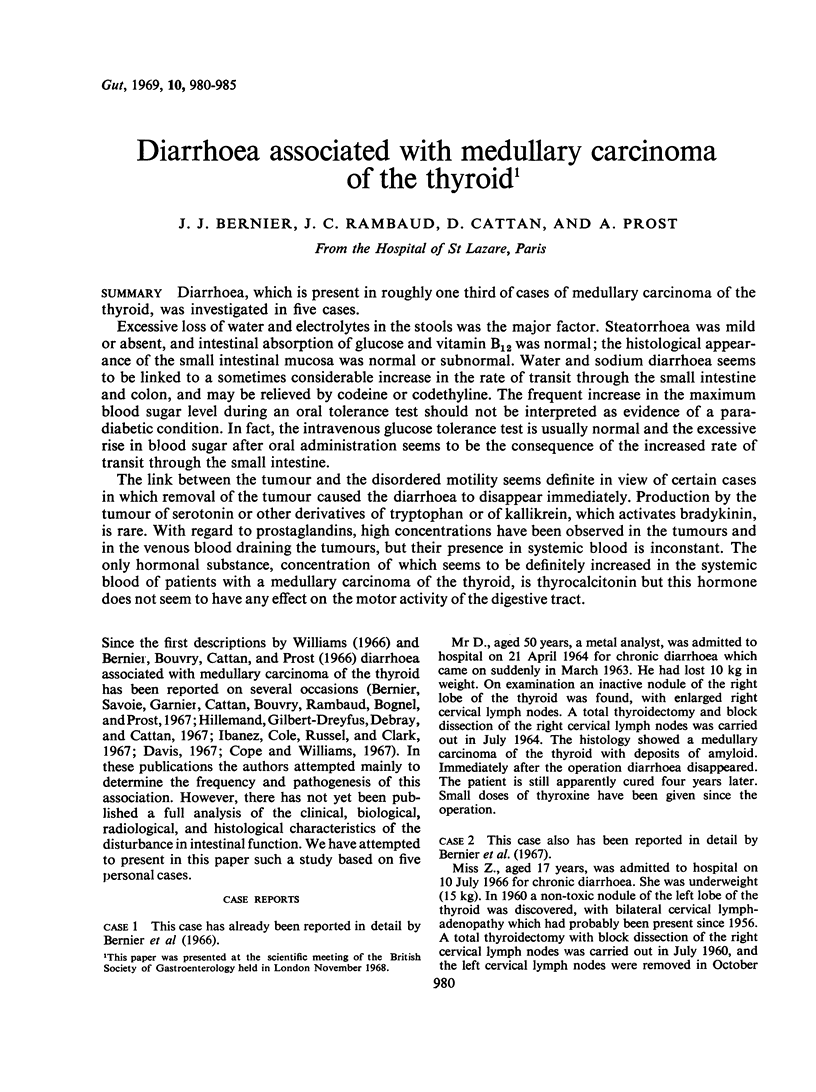
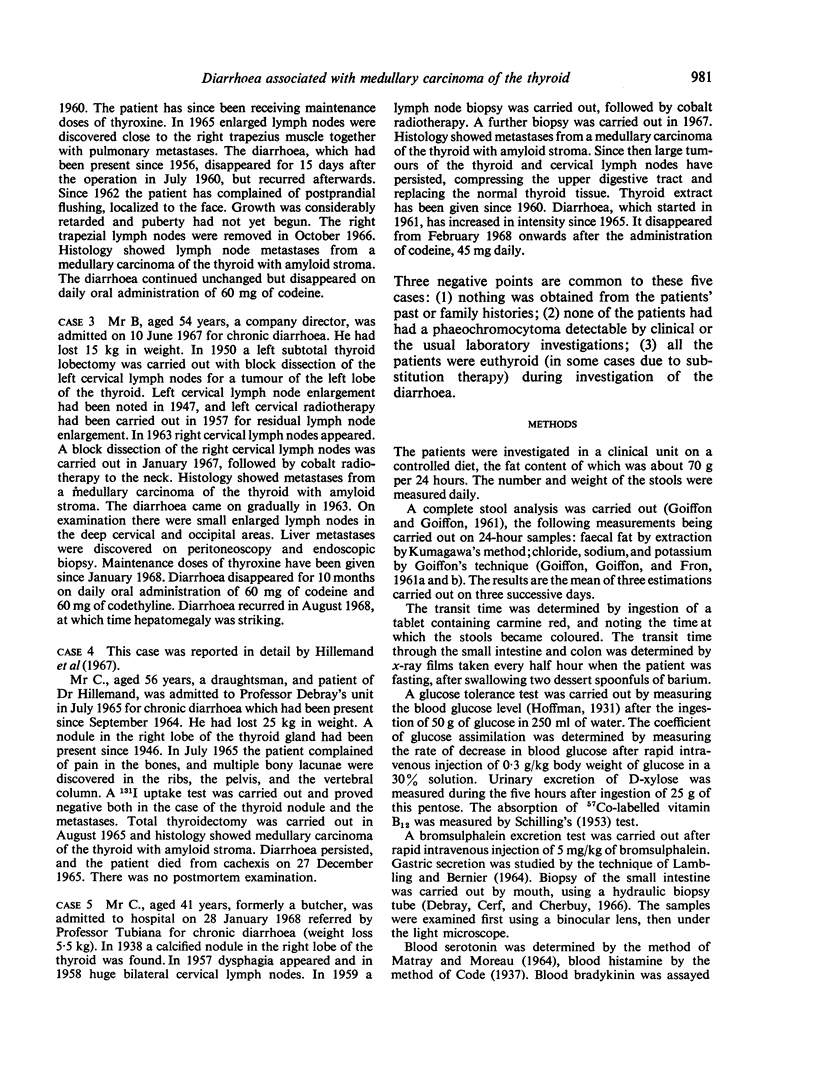
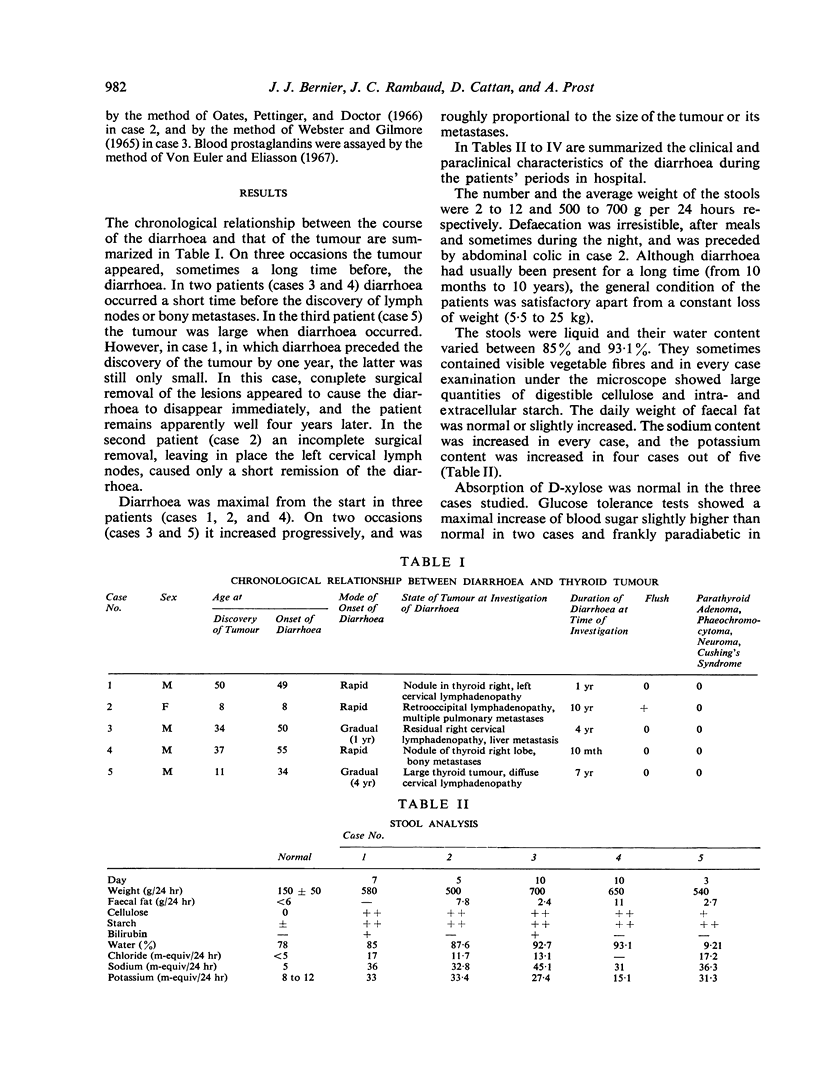
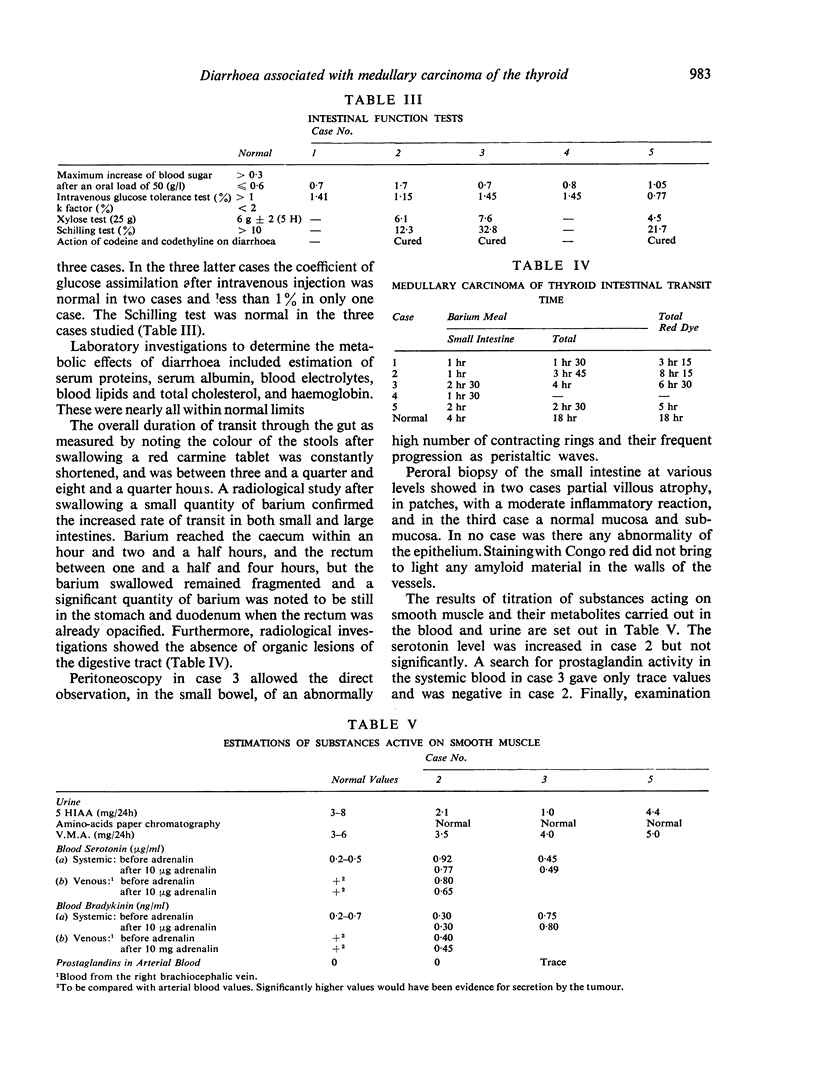
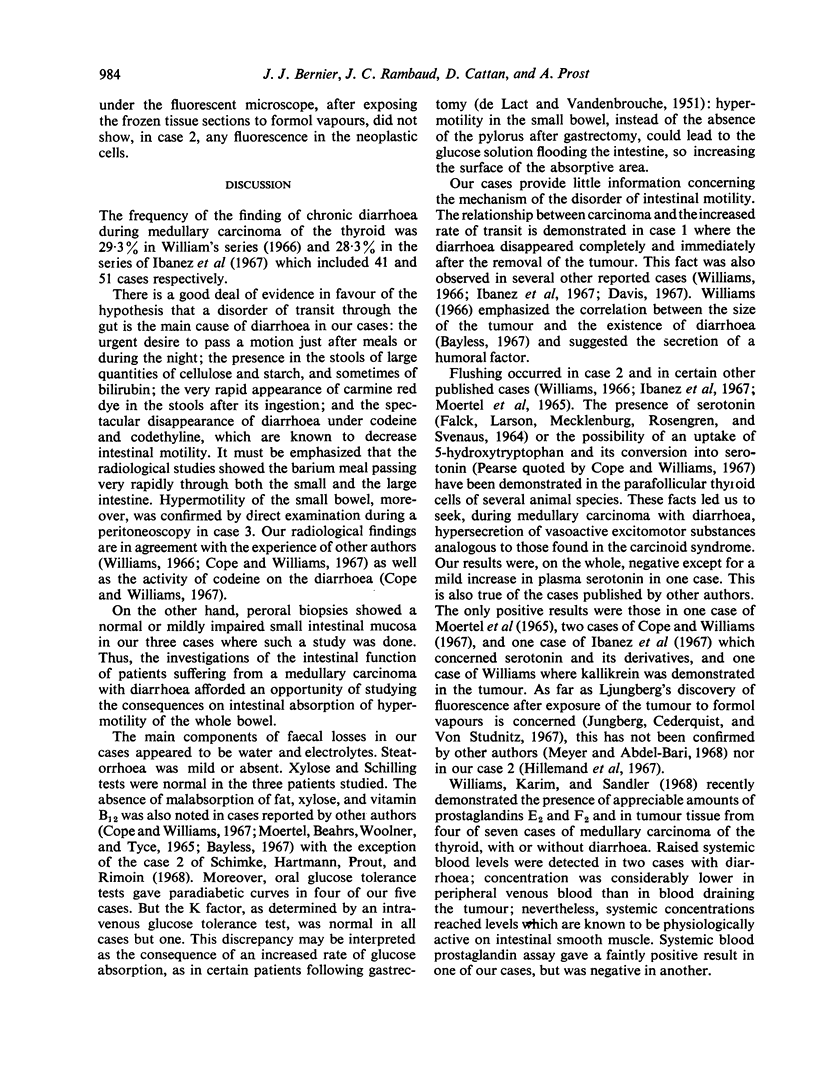
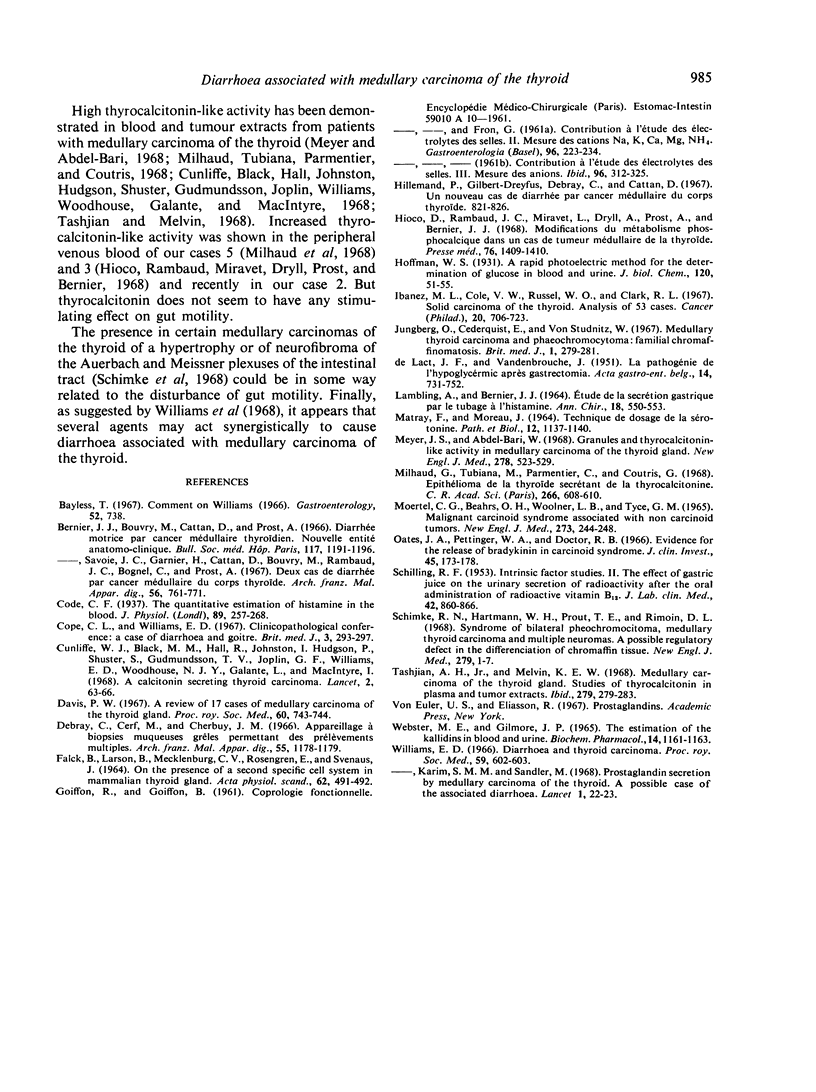
Selected References
These references are in PubMed. This may not be the complete list of references from this article.
- A case of diarrhoea and goitre. Demonstrated at The Royal Postgraduate Medical School. Br Med J. 1967 Jul 29;3(5560):293–297. doi: 10.1136/bmj.3.5560.293. [DOI] [PMC free article] [PubMed] [Google Scholar]
- Bernier J. J., Savoie J. C., Garnier H., Cattan D., Bouvry M., Rambaud J. C., Bognel C., Prost A. Deux cas de diarrhée par cancer médullaire du corps thyroïde. Arch Fr Mal App Dig. 1967 Sep;56(9):761–771. [PubMed] [Google Scholar]
- Code C. F. The quantitative estimation of histamine in the blood. J Physiol. 1937 Apr 9;89(3):257–268. doi: 10.1113/jphysiol.1937.sp003476. [DOI] [PMC free article] [PubMed] [Google Scholar]
- Davis P. W. A review of 17 cases of medullary carcinoma of the thyroid gland. Proc R Soc Med. 1967 Aug;60(8):743–744. [PMC free article] [PubMed] [Google Scholar]
- FALCK B., LARSON B., VON, ROSENGREN E., SVENAEUS K. ON THE PRESENCE OF A SECOND SPECIFIC CELL SYSTEM IN MAMMALIAN THYROID GLAND. Acta Physiol Scand. 1964 Dec;62:491–492. doi: 10.1111/j.1748-1716.1964.tb10449.x. [DOI] [PubMed] [Google Scholar]
- Hillemand P., Gilbert-Dreyfus, Debray C., Cattan D. Un nouveau cas de diarrhée par cancer médullaire du corps thyroïde. Arch Fr Mal App Dig. 1967 Sep;56(9):821–826. [PubMed] [Google Scholar]
- Ibanez M. L., Cole V. W., Russell W. O., Clark R. L. Solid carcinoma of the thyroid gland. Analysis of 53 cases. Cancer. 1967 May;20(5):706–723. doi: 10.1002/1097-0142(1967)20:5<706::aid-cncr2820200523>3.0.co;2-m. [DOI] [PubMed] [Google Scholar]
- LAMBLING A., BERNIER J. J. ETUDE DE LA SECR'ETION GASTRIQUE PAR LE TUBAGE 'A L'HISTAMINE. Ann Chir. 1964 May;18:550–553. [PubMed] [Google Scholar]
- Ljungberg O., Cederquist E., von Studnitz W. Medullary thyroid carcinoma and phaeochromocytoma: a familial chromaffinomatosis. Br Med J. 1967 Feb 4;1(5535):279–281. doi: 10.1136/bmj.1.5535.279. [DOI] [PMC free article] [PubMed] [Google Scholar]
- MATRAY F., MOREAU J. TECHNIQUE DE DOSAGE DE LA S'EROTONINE. Pathol Biol. 1964 Nov;12:1137–1140. [PubMed] [Google Scholar]
- Meyer J. S., Abdel-Bari W. Granules and thyrocalcitonin-like activity in medullary carcinoma of the thyroid gland. N Engl J Med. 1968 Mar 7;278(10):523–529. doi: 10.1056/NEJM196803072781002. [DOI] [PubMed] [Google Scholar]
- Milhaud G., Tubiana M., Parmentier C., Coutris G. Epithélioma de la thyroïde sécrétant de la thyrocalcitonine. C R Acad Sci Hebd Seances Acad Sci D. 1968 Feb 5;266(6):608–610. [PubMed] [Google Scholar]
- Oates J. A., Pettinger W. A., Doctor R. B. Evidence for the release of bradykinin in carcinoid syndrome. J Clin Invest. 1966 Feb;45(2):173–178. doi: 10.1172/JCI105329. [DOI] [PMC free article] [PubMed] [Google Scholar]
- SCHILLING R. F. Intrinsic factor studies II. The effect of gastric juice on the urinary excretion of radioactivity after the oral administration of radioactive vitamin B12. J Lab Clin Med. 1953 Dec;42(6):860–866. [PubMed] [Google Scholar]
- Schimke R. N., Hartmann W. H., Prout T. E., Rimoin D. L. Syndrome of bilateral pheochromocytoma, medullary thyroid carcinoma and multiple neuromas. A possible regulatory defect in the differentiation of chromaffin tissue. N Engl J Med. 1968 Jul 4;279(1):1–7. doi: 10.1056/NEJM196807042790101. [DOI] [PubMed] [Google Scholar]
- Tashjian A. H., Jr, Melvin E. W. Medullary carcinoma of the thyroid gland. Studies of thyrocalcitonin in plasma and tumor extracts. N Engl J Med. 1968 Aug 8;279(6):279–283. doi: 10.1056/NEJM196808082790602. [DOI] [PubMed] [Google Scholar]
- Webster M. E., Gilmore J. P. The estimation of the kallidins in blood and urine. Biochem Pharmacol. 1965 Jul;14(7):1161–1163. doi: 10.1016/0006-2952(65)90046-8. [DOI] [PubMed] [Google Scholar]
- Williams E. D. Diarrhoea and thyroid carcinoma. Proc R Soc Med. 1966 Jul;59(7):602–603. [PMC free article] [PubMed] [Google Scholar]
- Williams E. D., Karim S. M., Sandler M. Prostaglandin secretion by medullary carcinoma of the thyroid. A possible cause of the associated idarrhoea. Lancet. 1968 Jan 6;1(7532):22–23. doi: 10.1016/s0140-6736(68)90010-x. [DOI] [PubMed] [Google Scholar]


